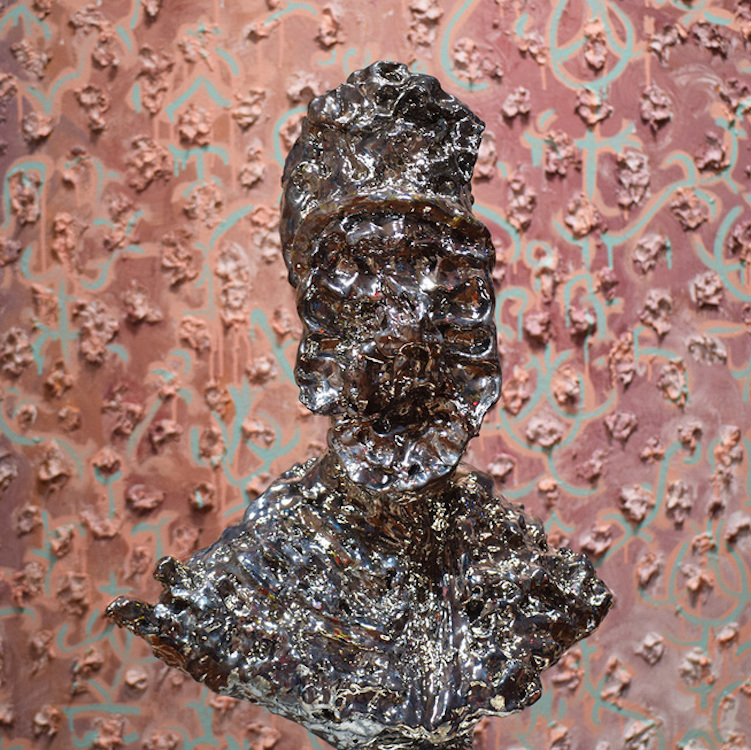We’re wrapping up a busy 2016 with some of our favorite posts of the year. These aren’t necessarily a “best ceramics of the year” list, but rather projects and exhibitions that got our brains firing in new and exciting ways. This piece about the sinister side of selfies ran on August 10th. If you haven’t acquainted yourself with Matthew Harris please do so now!
DENVER, Colorado — Denver-based artist Matthew Harris’ sculptures may look sloppy, but the corruption is a feature that takes him between two-to-three months to perfect. He’s intrigued by the theme of selfies, or more accurately, the thin illusion of appeal that runs through selfies. Baroque Selfies is currently on view at the Leon Gallery (Denver, July 30 – August 27).
The illusion of selfies isn’t addressed that often, but I promise you’re familiar with it. We see the illusion when someone poses at a three-quarter turn, trying to hide the chubbiness of their face. We see it in people forcing themselves to look nonchalant in a club, in acne that never would have made it to the Internet had the subject noticed it, in someone posing sexily in front of a bathroom mirror while a toilet that desperately needs to be flushed lurks in the background.
Above image: Baroque selfie of cardinal with new vestment (detail), 2015; glazed ceramic with paper mache and paint on canvas, 88 x 60 x 38 inches. Photograph by Judy Homburg. (Note what appears to be a Francis Bacon quote. – Bill).

Matthew Harris, Baroque Selfie of Prince on Vacation (detail), 2015; glazed ceramic with paper mache and paint on canvas, 88 x 60 x 38 inches. Photograph by Judy Homburg.
This illusion is different from the illusion of mass media. Your friend on Facebook may take joy in posting clickbait articles that prove models aren’t as untouchably gorgeous as they appear on covers of magazines, but I guarantee that same person has several selfies that were the products of many agonizing minutes. Does my chin look better if it’s inclined just so or just so? With mass media the illusion is coming from some outside agent; it’s projecting at us. With selfies the illusion comes from internalized ideas we’re projecting. Since we’re not as professional as mass media, the contrast between illusion and the grotesquely real is more pronounced.
The subject of a selfie is a mirage and like mirages the subject can’t abide much scrutiny. That’s what Harris’ sculptures do. Gleaming and heavenly from a distance, they turn ghoulish up close, comedic grotesqueries, gilded gargoyles.

Matthew Harris, Baroque Selfie of Soldier in Palace Garden (detail), 2015; iridescent acrylic on fired ceramic with paper mache and paint on canvas, 88 x 60 x 38 inches. Photograph by Judy Homburg.
To be honest, I think most commentary about social media and cell phones is about two-inches deep, an “old man yells at cloud” kind of rhetoric. But Harris works because he’s not too on-the-nose with it. His sculptures are a few steps removed from their inspiration, which means we can both see the inspiration within a new frame and apply those ideas to other topics. This turn from “awe” to “ew” can be applied to the display as well. Harris told 303 Magazine that each bust sits on top of a classically designed pedestal, against abstract backgrounds designed to reflect a particular mood. Harris knows that pedestals and plinths are messages to the viewer, even if the viewer doesn’t consciously realize it. A pedestal communicates the idea that whatever is sitting on top of it is deserving of that elevated space. That (like my attempts to hide my chubby cheeks from my cell phone camera) is an illusion. He states:
“My goal is to make a surface that is alluring, so people are drawn to it and then repulsed by it. I’m hoping that by putting it on these beautiful wooden structures that society has already deemed as worthy it allows them to accept this other thing, on top. And so the stands are allowing the viewer to enter the work but at the same time for the same reasons that are wrong in the ways we allow ourselves to enter into other people’s lives because we see that someone has something we want or is succeeding in a certain way.”

Installation view at UCCS Galleries of Contemporary Art, Colorado Springs. Photograph by Daisy McGowan.
In these works I can see my favorite kind of irony, where reading it as a condemnation of the subject is equally as wrong as reading it as presented. Irony is at its most interesting when it occupies an unexplored third space, where it’s triggering associations from the vanilla world but filtered through an uncanny lens. The fact Harris uses all of this to make people feel very uncomfortable is a cherry on top. I’d love to hang out in the gallery just to watch people react.
Matthew Harris is a Denver-based artist who received his Bachelor of Fine Arts in Ceramics at the University of Wisconsin, Madison, WI, according to the gallery. He has recently been exhibited in a group show at RedLine, “Jokes of Nature”, commissioned for the USA Pro Challenge Bike Art Project at the Denver International Airport in Denver, CO, and has had a solo-exhibition at the UCCS Galleries of Contemporary Art in Colorado Springs for his most recent series of work, Baroque Selfies.
Bill Rodgers is the Managing Editor of cfile.daily.
Do you love or loathe these works of contemporary ceramic art? Let us know in the comments.




Add your valued opinion to this post.